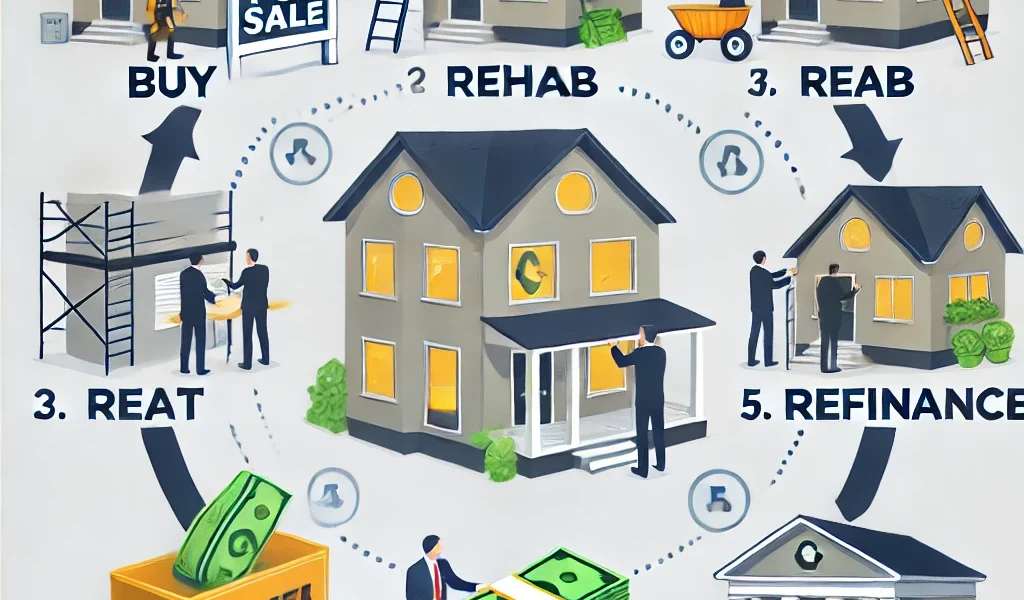The BRRRR strategy has become one of the most popular real estate investment methods in recent years. It provides a structured approach that allows investors to scale their rental property portfolios effectively while maximizing returns. In this guide, we will explore each step of the BRRRR strategy in detail, offering insights on how to implement it successfully while mitigating risks.
What is the BRRRR Strategy?
The BRRRR strategy stands for:
- Buy – Purchase a distressed or undervalued property.
- Rehab – Renovate the property to increase its value.
- Rent – Lease the property to generate rental income.
- Refinance – Secure a new loan based on the improved value.
- Repeat – Use the refinanced capital to reinvest in another property.
This strategy is particularly effective for real estate investors who aim to grow their portfolios without tying up large amounts of capital.
Step 1: Buying the Right Property
The success of the BRRRR strategy begins with selecting the right property. Here are key factors to consider:
- Market Research: Identify neighborhoods with strong rental demand, economic growth, and potential appreciation.
- Distressed Properties: Look for properties that require repairs but have the potential for increased value post-renovation.
- Purchase Price: Aim to buy properties at a discount, typically 70% or less of the after-repair value (ARV), minus renovation costs.
- Financing Options: Secure financing through cash, hard money loans, private lenders, or traditional mortgages.
Pro Tip: Conduct a thorough inspection and get an accurate estimate of repair costs before purchasing.
Step 2: Rehabbing the Property
Renovation is essential for improving property value and attracting quality tenants. Focus on cost-effective upgrades that provide the highest return on investment (ROI):
- Structural Repairs: Address any major issues like plumbing, electrical, and roofing.
- Cosmetic Enhancements: Fresh paint, updated flooring, modern kitchens, and bathrooms add significant value.
- Curb Appeal: Landscaping and exterior improvements create a positive first impression.
- Energy Efficiency: Installing energy-efficient appliances and windows can reduce utility costs, attracting more tenants.
Budgeting Tip: Avoid over-improving the property. Stick to essential renovations that enhance value without overspending.
Step 3: Renting the Property
Once renovations are complete, it’s time to find tenants. A well-managed rental property ensures steady cash flow and enhances refinancing prospects.
- Competitive Rental Pricing: Research local rental rates to set a competitive price.
- Tenant Screening: Conduct background checks, verify income, and check references to ensure reliable tenants.
- Lease Agreements: Use legally compliant lease agreements that protect both the landlord and tenant.
- Property Management: Decide whether to self-manage or hire a property management company.
Tip: High-quality tenants reduce vacancy rates and minimize maintenance issues.
Step 4: Refinancing the Property
Refinancing allows investors to pull out the equity built through property appreciation and renovations. The key steps include:
- Seasoning Period: Some lenders require a holding period (usually 6-12 months) before refinancing.
- Appraisal Process: The lender will assess the property’s new value after renovations.
- Loan Terms: Seek favorable terms, such as low-interest rates and cash-out options.
- Debt-to-Income Ratio (DTI): Ensure that your rental income and personal finances meet lending criteria.
Smart Move: Work with lenders experienced in investment property refinancing for a smoother process.
Step 5: Repeating the Process
With funds secured from refinancing, the investor can reinvest in another property and repeat the BRRRR strategy. Key considerations include:
- Expanding Your Portfolio: Gradually scale your investments while maintaining cash flow.
- Building Relationships: Network with lenders, contractors, and real estate agents for future deals.
- Financial Discipline: Reinvest profits wisely while maintaining emergency funds for unexpected expenses.
Growth Strategy: Over time, a well-executed BRRRR strategy can lead to financial independence through passive rental income.
Risks and How to Mitigate Them
While the BRRRR strategy offers excellent growth potential, it is essential to be aware of possible risks:
- Overpaying for Properties: Conduct thorough due diligence to avoid overestimating ARV.
- Underestimating Rehab Costs: Always get multiple contractor quotes and include contingency funds.
- High Vacancy Rates: Invest in high-demand rental areas to ensure occupancy.
- Loan Denial for Refinancing: Maintain good credit and keep detailed financial records.
- Market Fluctuations: Monitor real estate trends and adjust your strategy accordingly.
Final Thoughts
The BRRRR strategy is a powerful tool for real estate investors looking to scale their portfolios systematically. By carefully selecting properties, executing smart renovations, securing quality tenants, refinancing wisely, and reinvesting strategically, investors can achieve long-term financial success. However, it is crucial to stay informed, adapt to market conditions, and practice sound financial management.
If executed correctly, BRRRR can be a game-changer for those seeking to build wealth through real estate. Ready to get started? Begin researching your market, connect with industry professionals, and take the first step toward financial freedom through real estate investing!




